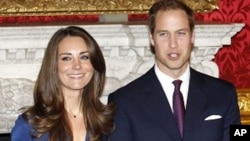Kate Middleton on Friday will become the British royal family's latest princess. She may have been born a commoner, but the royal family seems to have welcomed her despite her lack of pedigree. History proves that does not mean smooth sailing in a royal marriage.
In 1525, the notorious Anne Boleyn, also a commoner, caused a scandal when she caught the eye of King Henry VIII. The king sought an annulment of his 24-year marriage to Catharine of Aragon to pursue Boleyn, which the pope refused to grant. Henry broke off from the Roman Catholic Church and established himself as head of the new Church of England, divorced Catharine, and married Boleyn.
Three years later, the king had Boleyn beheaded for adultery and conspiring to overthrow him.
More recently, the palace was faced with another controversial partner for a king - Wallis Simpson, an American socialite and divorcee who attracted the affections of then-Prince Edward, heir to the throne. Because of her history of divorce, and the king’s status as head of the Church of England, the palace did not see her as a viable choice for queen. In 1936, in order to marry her, King Edward VIII took the unprecedented step of abdicating the throne.
A generation later, Princess Margaret - sister to today’s Queen Elizabeth - had an affair with Peter Townsend, an officer in the royal household. Again, a previous divorce made this royal suitor unfit in the eyes of the palace. Margaret accepted Townsend’s proposal, but after two years, announced she would not marry him after all. Instead she married photographer Antony Armstrong-Jones, a marriage that ended in divorce in 1978. She was reported to have carried on affairs with a number of men before her death in 2002.
In a unique position is the former Camilla Shand, who met Prince Charles at a polo match in the early 1970s. She was among several women with whom he was linked at the time, but the relationsip ended when Charles left the country for military service two years later.
But Camilla was to have her turn. She and Charles resumed their affair during his marriage to Princess Diana and hers to Andrew Parker Bowles. Diana, also unhappy in the marriage, had affairs of her own; Charles and Diana divorced in 1996, and in 2005 he wed Camilla Parker Bowles. Since then, she has gone from royal reject to palace insider, gradually gaining the acceptance of the royal family and the general public.
Another woman who entered, then exited, the royal family was Sarah Ferguson, who married Prince Andrew, brother of Charles. That marriage dissolved after 10 years. Ferguson has since had a string of financial troubles and in 2010 was caught on videotape soliciting money in exchange for access to her ex-husband. Earlier this year, she admitted accepting financial help from a convicted pedophile and friend of Prince Andrew, Jeffrey Epstein. She later issued a public apology.
A third royal sibling, Princess Anne, suffered embarrassment when it was revealed that her then-husband, Mark Philips, fathered a child in 1985 with New Zealand art teacher Heather Tonkin. A paternity test in 1991 confirmed he was the father. Philips and Princess Anne divorced in 1992, the same year both Charles and Andrew announced their marital separations.
But the palace also has seen many successes, the latest being that of Queen Elizabeth and Prince Philip, who have remained married for 64 years., While three of the queen’s children have gone through divorces, her youngest son, Prince Edward, remains married since 1999 to Sophie Rhys-Jones, Countess of Wessex, who is said to have a close relationship with the queen.
Where the newest royal marriage will fall on the scandal scale remains to be seen. The eight years of courtship between Prince William and Kate Middleton have been relatively quiet, which may bode well for their union. But whether their life together is smooth or scandalous, the world - and royal historians - will be watching.











